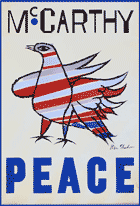 It was different then. We weren’t worried about hedge-fund bankers, but rather about a war that would drag 2.7 million of us to Vietnam and kill 58,000 Americans. But the political revolution started the same way, with students shocking the Democrats in the New Hampshire primary. They didn’t get their man nominated in ’68, but as we’ll see later, they returned to do that in ’72. And then … stay tuned …
It was different then. We weren’t worried about hedge-fund bankers, but rather about a war that would drag 2.7 million of us to Vietnam and kill 58,000 Americans. But the political revolution started the same way, with students shocking the Democrats in the New Hampshire primary. They didn’t get their man nominated in ’68, but as we’ll see later, they returned to do that in ’72. And then … stay tuned …
1968:
We took down LBJ; he flew in 5,000 federal troops
Before the Revolution
Lyndon Johnson (LBJ) had passed the Civil Rights Bill in 1964, and the war-on-poverty legislation—Medicare, Medicaid, Food Stamps, VISTA, Job Corps, the Community Action Program, the Education Act, and the Voting Rights Act—came close on its heals. All this in less than two years. What made this possible? First, the social movements of the time, mainly the Civil Rights Movement, but also the widespread concern with poverty and hunger in America, catalyzed by (democratic socialist) Michael Harrington’s book The Other America.
But congressional strength was also all-important. President Kennedy’s assassination made him more popular than ever, and Johnson leveraged that for Civil Rights. Then Barry Goldwater attempted a conservative revolution. Attacking the “moderate Republican establishment,” he famously declared “moderation in the pursuit of justice is no virtue.” His run for president increased the Democrats’ lead in the Senate by two and their lead in the House by 72, giving LBJ better than a 2/1 majority in each.
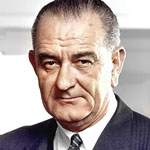 Ironically the greatest-ever surge of progressive legislation was guided by the oh-so-establishment Lyndon Baines Johnson, and passed by a not-at-all radical Congress. But times change quickly, and three years later Johnson fell victim to the rising tide of a political revolution from the Left. This first post on the ’60s explains what started that revolution.
Ironically the greatest-ever surge of progressive legislation was guided by the oh-so-establishment Lyndon Baines Johnson, and passed by a not-at-all radical Congress. But times change quickly, and three years later Johnson fell victim to the rising tide of a political revolution from the Left. This first post on the ’60s explains what started that revolution.
The end of progress brings the start of the revolution
By 1968 the Vietnam war was raging with troop levels headed to 550,000 by the end of the year. In Oct ’67, nearly 100,000 anti-war protesters had met at the Lincoln Memorial in DC and 30,000 of them headed off to attempt an “exorcism” and “levitation” of the Pentagon.
By February 50% disapproved of President Johnson’s handling of the war, but a large majority of the public did not favor stopping the war. In late 1967 Allard Lowenstein started the Dump Johnson movement. He first tried to recruit Senators Bobby Kennedy and George McGovern. Both declined but he succeeded in convincing Senator Gene McCarthy to run for President.
Clean Gene in New Hamsphire
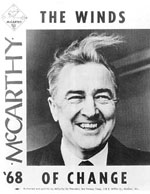 After seven weeks of campaigning, when McCarthy visited Stanford, he was greeted by newspaper headlines that asked whether he “want[ed] to make righteous speeches…or end the Vietnam War.” Such comments caused him to focus on winning in New Hampshire, which gained him strong support from young radicals many of whom were also part of the hippie culture. To support him more effectively in rural New Hampshire, many of them cut their hair and shaved their beards to be “clean for Gene” who was polling at 10 to 20%. And on March 12 he won an astounding 42% to Johnson’s 49%.
After seven weeks of campaigning, when McCarthy visited Stanford, he was greeted by newspaper headlines that asked whether he “want[ed] to make righteous speeches…or end the Vietnam War.” Such comments caused him to focus on winning in New Hampshire, which gained him strong support from young radicals many of whom were also part of the hippie culture. To support him more effectively in rural New Hampshire, many of them cut their hair and shaved their beards to be “clean for Gene” who was polling at 10 to 20%. And on March 12 he won an astounding 42% to Johnson’s 49%.
Pre-convention chaos
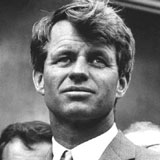 Four days later, Bobby Kennedy entered the race, and on March 31, President Johnson announced he was dropping out. (Four days after that, Martin Luther King was assassinated.) By the time of Bobby Kennedy’s assassination on June 4th, the eve of his victory in the California primary, the delegate totals were Humphrey 561, Kennedy 393, McCarthy 258.
Four days later, Bobby Kennedy entered the race, and on March 31, President Johnson announced he was dropping out. (Four days after that, Martin Luther King was assassinated.) By the time of Bobby Kennedy’s assassination on June 4th, the eve of his victory in the California primary, the delegate totals were Humphrey 561, Kennedy 393, McCarthy 258.
So how did Humphrey, LBJ’s stand-in, get so many? He did not enter a single primary! Back then there were only only 14 states with primaries and Humphrey concentrated on winning the delegates in non-primary (caucus) states, where party leaders controlled the delegate votes in their states. Of the popular vote, McCarthy won 39%, Kennedy 31% and Humphrey/Johnson and their stand-ins got only 28%. So the anti-war vote was more than double the pro-war vote.
But, with Kennedy dead, his delegates were uncommitted. This, combined with the mystery of the non-primary states, created rampant speculation that the Democratic Convention in August in Chicago would be rigged.
“The whole world is watching”
In 1964, LBJ had been elected with the second-biggest landslide in 100 years. But even though he had dropped out of the 1967 race, he was still Commander in Chief, and he had Humphrey to continue his war with 500,000 troops in Vietnam. Over the summer, everyone was discussing the coming demonstrations at the Democratic Convention in Chicago, Aug 25 – 29. MOBE, the anti-war mobilization committee invited 500 anti-war groups to the convention, and LBJ flew in 5,000 Federal troops, just in case. Mayor Daley called up the National Guard and put Chicago police on 12-hour shifts. According to CNN, “anti-war demonstrators clashed with 11,900 Chicago police, 7500 Army troops, 7500 Illinois National Guardsmen and 1000 Secret Service agents over five days.” (That’s 27,900 in total.)
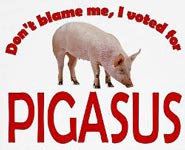 Three days before the convention, Yippie leader Jerry Rubin, folk singer Phil Ochs, and others nominated Pigasus, a 145-pound pig, for president. When they paraded Pigasus at the Civic Center, Ochs, Rubin, Pigasus, and six others were arrested. Their trial was covered by CBS, NBC, ABC, the Washington Post, the New York Times, the AP and UPI.
Three days before the convention, Yippie leader Jerry Rubin, folk singer Phil Ochs, and others nominated Pigasus, a 145-pound pig, for president. When they paraded Pigasus at the Civic Center, Ochs, Rubin, Pigasus, and six others were arrested. Their trial was covered by CBS, NBC, ABC, the Washington Post, the New York Times, the AP and UPI.
Also according to CNN, “The violence began Sunday, August 25th. Anti-war leaders had tried to get permits from the city to sleep in Lincoln Park and to demonstrate outside of the convention site. Those permit requests were denied, although the city did offer them a permit to protest miles away from the Amphitheater. But the protesters were undeterred. When the park was officially closed, Chicago police bombed protesters with tear gas and moved in with billy-clubs to forcibly remove them from the park. Along with the many injuries to anti-war protesters, 17 reporters were attacked by police (including Hal Bruno, who was then a reporter for Newsweek and is now political director for ABC.) Throughout the convention, police would see the press as the enemy. Subsequent battles between police and protesters occurred nightly in Lincoln Park and Grant Park.”
“The worst day of protesting was Wednesday, Aug 28, … Continued here

